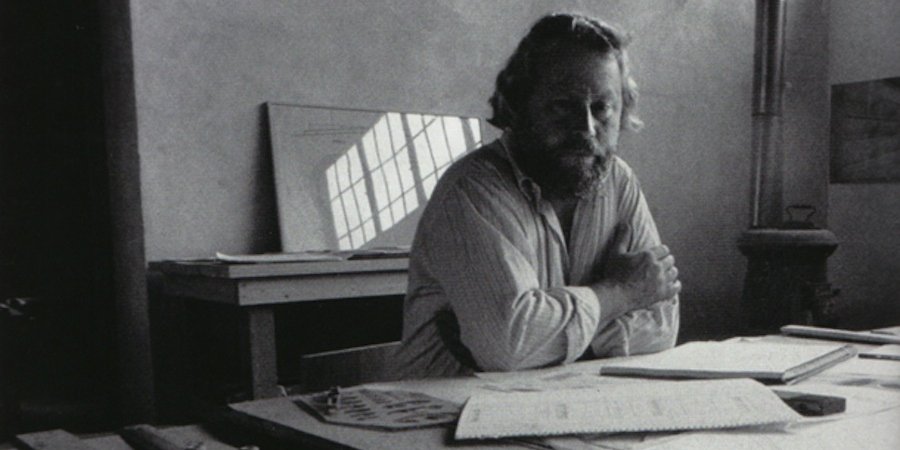Artists have always had a complicated relationship with art criticism. “Do not be an art critic, but paint; therein lies salvation,” Paul Cézanne wrote to fellow painter Émile Bernard in 1904. Eugene Delacroix wrote an entire essay on the subject in 1829 called “On Art Criticism,” in which he found that art critics—or “watchful dragons” as he called them—“have always presented difficulties…. Far from contributing to the advancement of art, these discussions embroil the simplest questions, and twist all ideas out of shape.” If artists and art critics are such separate species, what are we to think of artists who themselves are art critics? There a surprising number of them.
DONALD JUDD
Donald Judd was a famous example, writing monthly reviews in Arts Magazine from 1959-65. In review after review, Judd’s opinions are clear, often in as few, flatly stated words as possible:
– On Adolph Gottlieb at Sidney Janis Gallery in 1960: “This is an unsatisfactory show for the most part. The dualistic symbolism has always been to simple and archaic. It is essayed with waning conviction here.”
– On Pablo Picasso at the Whitney in 1963: “A few of these linoleum cuts, all done in 1962, are simply glib and corny, a majority combine these characteristic aspects and a reasonable degree of form, and a few are good.”
– On Lygia Clark at Alexander Gallery in 1963: “This sheet-metal sculpture is made of hinged segments and rectangles which adjust to various positions. The idea is clever. The style is ordinary capable Constructivism. Lygia Clark works and is well known in Brazil.” That’s the whole review.
– On the up-and-comer Roy Lichtenstein: “Lichtenstein's paintings are some of the most interesting done in recent years. His representation of a comic panel, in itself a representation, was a thoroughly surprising development.”
At the time, Judd’s style was not universally beloved. He was fired from Art International before either of his two “New York Letter” columns were published; the editor, James Fitzsimmons, broke the news to Judd in a letter opening: “Hail and farewell!” It's “not because what you say isn’t to the point or worth saying but simply, again because of the shambling basic-Hemingway you elect to write it,” Fitzsimmons explained. Judd was not dissuaded. He continued to write into the '70s. (New York Times critic Roberta Smith worked for Judd in the late '60s and early '70s and typed up all of his reviews in to manuscript form, and once said that, after she was done, "I had completely inhaled Judd—his thinking, his style, his vocabulary.")
MEL BOCHNER
Considering the backlash from fellow artists (and on occasion editors or other critics), why do artists write criticism? Judd claimed that he wrote criticism “as a mercenary and would never have written it otherwise.” Do we believe him? Of course not. Neither does Mel Bochner. Bochner, who took over Judd’s critic post at Arts Magazine in 1965, counters that “Judd wrote in order to get out of his studio and into the trenches” similarly to “Truffaut and Godard, who regularly reviewed films in Cahiers du Cinema in order to create the taste required to appreciate their own as yet unmade work.” Therein lies one power of the artist-critic: the position to develop the audience for their own work.
For his part, Bochner introduces the compilation of his own writings, Solar Systems & Rest Room, by admitting that at first “it never occurred to me that reviewing was anything more than a job to pay the rest, or that anybody took what I wrote seriously. That all changed in 1966.” That year, at a party full of well-known New York School painters, Bochner confessed to being the critic behind a hotly contested review—and his confession made the painters boil. “They realized that the barbarians were already inside the gate,” he wrote. Similar situations ensued, but for Bochner, “Realizing it was impossible not to be misunderstood gave me an enormous sense of freedom.” No longer was it solely the $2.50 per review.
The “freedom” led to Bochner and Robert Smithson joining forces to write “The Domain of the Great Bear,” their response to gallerists’ requests for reproduction. The duo made a work that was solely a reproduction. With that, an early example of Conceptual Art entered stage left. Similarly, Dan Graham used Arts Magazine as the medium for/vehicle to distribute his famous early work Homes for America, a conceptual intervention in the magazine format. (Before that, Graham, now the master of the pavilion, was a rock critic for The New York Review of Sex as well as a gallerist and occasional art critic.)
MARSDEN HARTLEY
Before and after Judd and conceptual art, artist-critics were laying the cultural foundations for their own work and demanding more of art criticism at large. The early 20th-century American painter and poet Marsden Hartley’s art criticism captures the topics of his time: Cézanne’s new watercolors and how the Americans compare; Alfred Stieligz and photography; what's next for Georgia O’Keeffe; how to spread modern art in American—“Art in American is like a patent medicine, or a vacuum cleaner. It can hope for no success until ninety million people know what it is.”
Hartly also wrote an essay called “The Dearth of Critics” asking and answering, “Why do so many people who write specifically about painting say so little that really relates to it? It is because most of them are journalists or men of letters who have made emotional excursions into this field, which is in most instances foreign to them.”
BARNETT NEWMAN
Too infrequently for us, Barnett Newman and Robert Motherwell, both known beyond their artistic practice as thinkers and writers, ventured into criticism. Newman’s 1945 review of two solo shows of his friend Milton Avery began: “Milton Avery is an example of an advance-guard painter who has achieved the highest success without having his work properly understood.” In order to understand Avery, Newman suggested looking to other painters’ attitudes towards Avery’s changing styles instead of the “journalistic attitude that forms the basis of his popular acclaim among collectors.”
JOHN MILLER
American artist John Miller has written criticism regularly since the '70s. His friend, the late artist Mike Kelley, asserted that for artists in general, and specifically for Miller, the main motivation for writing criticism “is that the critical establishment was not addressing his cultural concerns.” Miller’s prolific career (already compiled in three volumes and counting) has included pieces on Artschwager, Baldessari, and Ruscha in the '80s, Jason Rhoades in the '90s, and Sarah Lucas in the '00s.
WALTER ROBINSON
What of today’s artist-art critics? Peter Halley and Artspace regular Walter Robinson are both noted critic and painters. Of the artists to watch, Julia Dault wrote a weekly column “At the Galleries” for Canada’s National Post newspaper. That's just to name just a few.
Surprisingly, Delacroix concludes “On Art Criticism” by instructing his fellow artists that critics make people “aware of your awkwardness or your attractiveness. There, repay with a little gratitude all the care they take in order to make something of you.” With the artist-critic, however, maybe it’s the art audience that is being groomed.
























